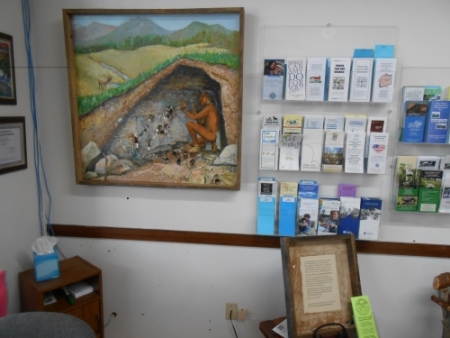Aboriginal Native American Mica Mining
in Western North Carolina
"The Painting"
Last Updated: February 19th, 2018
/ Home / Painting / 2012/ 2013 / Back Story and Research
Concept by Robert S. 'Bo' Smith, Painting by well known local artist Jerry Newton , Digital Image by Kay Workman
This painting illustrates what Native American mica mining might have looked like in Mitchell County in western North Carolina during the Mid-Woodland Period (300BC-500AD). It is based upon a story told by a local man and considerable research which is described in detail in the "Back Story and Research" and "2012"webpages. The lower right portion of the painting depicts a mining tunnel discovered in the early 1950s. Mining tools and pieces of mica were found on the floor near the back wall mica vein. Mica from the Sink Hole Mine has been found in the form of ornamental objects, in sheets of mica lining the inside of "burial mounds" of the Hopewell Tradition Native Americans in Ohio, and in caches of mica buried near the "mounds". We have added the Native American miner in the mining site of the painting.. The miner represents two possible viewpoints; either that local Native Americans were active traders with the Hopewell "Mound People" to the north in Ohio or that the Hopewell came to the area, set up temporary camps and did the mining themselves. Archeological studies have been conducted in the past and may be conducted in the future to determine which is more likely. The earring is made of copper and is Hopewell in origin. The loin cloth may or may not have been worn. The ankle high single piece moccasins are typical of the Mid-Woodland Period. The painting is mixed media consisting of acrylic, oil, and natural materials. High quality Muscovite Mica and highly weathered mica vein Feldspar and clay material from the Sink Hole mine have been used in the mine portion of the painting. The Elk represents in increased distribution of Elk into the southeast during the period. The river represents the North Toe River which is located just to the west of the mine site. The river flows south to north into Tennessee and would have provided an excellent mode of transportation of mica and mining supplies back to Ohio during the fall. The percentage of grass land and deciduous trees was probably dependent on the annual amount of rainfall during the period. The observer can conclude that the painting represents either that the trees are intruding in to the grass land or receding.
Click HERE to see a close up view of the mining section of the painting.
The painting is currently on display for the public at the Yancey County Visitor's Center in Burnsville, NC
 |
The painting was officially presented to the public at the North Carolina Gem and Mineral Show, Pineridge Center, Spruce Pine, NC on August 3rd, 2013.
Since then, it has been on loan for public display at the Yancey County Visitor's Center from 2013 to the present except for a short period where it was loaned to The Blowing Rock Museum of Art and History from December 2015 through April 2016 for their 2016 Winter Exhibition. I donated the painting to The Yancey History Association in Decemebr 2017 with the stipulation that the painting be on public display usually at the Chamber of Commerce lobby (AKA Yancey County Visitor''s Center.)
/ Home / Painting / 2012 / 2013 / Back Story and Research
Website created by Robert S. "Bo" Smith